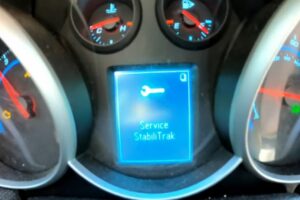Common Citroen Relay Van Problems include gearbox problems, engine issues, electrical faults, turbocharger problems, and suspension issues. Understanding these issues and how to identify and address them can help owners keep their Citroen Relay running smoothly and minimize downtime.
Owning a Citroen Relay van has its perks – impressive cargo capacity, comfortable ride, and sleek styling among them.
However, as with any vehicle, problems can pop up that throw a wrench in even the most strategic maintenance plan.
Luckily, Relay vans tend to have common issues that are easy to identify and address if you know what to look for.
Even if you’re not an experienced auto mechanic, being able to troubleshoot basic Citroen Relay Van Problems can save you time, money, and headaches.
In this article, we’ll explore 6 of the most common Citroen Relay van problems owners face and provide solutions to get you back on the road.
From starting issues and turbo failures to cold start problems and gearbox leaks, we’ve got you covered. Each section outlines symptoms to watch for, possible fixes, and things to keep in mind to avoid recurring citroen relay van common problems.
Table of contents
Here are the 6 Most Common Citroen Relay Van Problems:
| Problem | Description |
|---|---|
| Gearbox problems | Hub clips can break inside the hub and make it difficult or impossible to select a gear. The synchromesh on these gearboxes are very fine, and are prone to wear. |
| Engine problems | Solenoid valves can fail, causing the van to stall. The EGR valve can become clogged with carbon, causing the van to go into limp mode or emit excessive smoke. |
| Electrical problems | Faulty wiring can cause a variety of problems, including lights not working, the dashboard not working, and the van not starting. |
| Suspension problems | The front suspension dampers can wear out prematurely, causing the van to ride rough. |
| Brake problems | The brake assist vacuum pump can fail, reducing braking power. |
1. Gearbox Problems: Citroen Relay Van Common Problems
Gearbox malfunctions can jeopardize the safety and reliability of long-distance hauling vehicles, impacting the productivity and profitability of businesses that rely on them.
The Citroen Relay van is no exception to this, and it has been known to experience several gearbox problems.
Some of the common issues include the breaking of hub clips, synchromesh wear, and end float, which can result in the van jumping out of gear. These problems can occur due to wear and tear or incorrect gearbox oil.
Regular oil changes and using the correct gearbox oil can help prevent some of these issues.
Additionally, it is crucial to address glow plug issues promptly, which can cause starting problems and put additional strain on the gearbox.
2. Engine Problems: Citroen Relay 2.2 Engine Problems
One of the critical components of a reliable long-distance hauling vehicle is a well-maintained engine that can power through demanding conditions and keep up with the demands of daily use.
However, the Citroen Relay van has been known to experience a range of engine problems that can affect its reliability and performance.
Common issues include clogged DPF, solenoid valve issues, EGR valve problems, glow plug issues, and starter motor issues.
To provide more detail, the table below summarizes the most common engine problems associated with the Citroen Relay van:
| Engine Problem | Symptoms | Solution |
|---|---|---|
| Clogged DPF | Reduced power, poor fuel economy, engine warning light | Clean or replace the DPF filter |
| Solenoid valve issues | Rough idling, poor acceleration | Replace the faulty solenoid valve |
| EGR valve problems | Reduced power, black smoke emissions | Clean or replace the EGR valve |
| Glow plug issues | Difficulty starting the engine | Replace the faulty glow plug |
| Starter motor issues | Grinding noise, slow starting | Replace the faulty starter or battery if it’s the issue |
It is essential to address these engine problems as soon as possible to prevent further damage to the van and ensure its longevity.
Regular engine maintenance, including oil and filter changes, can go a long way in preventing these issues from occurring.
Additionally, if you are purchasing a used Citroen Relay van, it is important to inspect the engine thoroughly and watch out for any warning signs of these common problems.
3. Electrical Issues: Citroen Relay Van Problems

Electrical malfunctions are a potential source of concern for owners of the Citroen Relay van, as these issues can cause a range of problems that affect the vehicle’s performance and safety.
Here are some common electrical issues that owners may encounter and some possible solutions:
Fuse box issues:
The Citroen Relay van’s fuse box is located on the dashboard, and it contains fuses that protect the vehicle’s electrical systems. If a fuse blows, it can cause problems with the affected system.
To diagnose a blown fuse, owners can check the fuse box and replace any blown fuses. It is important to use the correct amperage fuse to avoid damaging the system.
Wiring harness problems:
Wiring harnesses are bundles of wires that carry electrical signals to various parts of the vehicle. If a wiring harness becomes damaged or corroded, it can cause problems with the affected system.
To diagnose a wiring problem, owners can visually inspect the wiring harnesses for damage, use a multimeter to test for continuity, and repair or replace any damaged wiring.
Battery maintenance:
The battery is an essential component of the Citroen Relay van’s electrical system, and it needs to be maintained to ensure reliable performance.
Owners should regularly check the battery’s condition, clean the terminals, and replace the battery if it is old or damaged.
Dashboard warning lights:

The Citroen Relay van’s dashboard has warning lights that indicate when there is a problem with the vehicle’s systems.
If a warning light comes on, owners should consult the owner’s manual to determine the cause of the problem and take appropriate action.
Ignoring warning lights can lead to further damage and more expensive repairs.
4. Turbocharger problems:
The turbocharger in the Citroen Relay van is a vital component that boosts the engine’s power by compressing the incoming air and increasing its density before it enters the combustion chamber.
A faulty turbocharger can significantly impact the van’s performance, resulting in reduced power output, increased fuel consumption, and potential engine damage.
Turbocharger failures can be caused by a variety of factors, including wear and tear, lack of maintenance, and oil contamination.
Symptoms of turbocharger issues include a loss of power, excessive smoke from the exhaust, unusual noises, and reduced fuel economy.
Replacing a faulty turbocharger can be a costly repair, with prices ranging from £500 for a reconditioned unit to over £1000 for a new one.
Preventative maintenance for turbochargers includes regular oil changes, using a high-quality oil and air filter, and avoiding harsh driving conditions.
Regularly checking the turbocharger for signs of damage or wear can also help prevent costly repairs.
It is essential to address any symptoms of turbocharger issues promptly to prevent further damage to the engine and to avoid costly repairs.
5. Suspension problems:
A well-maintained suspension system is essential for ensuring a smooth and safe ride in commercial vehicles such as the Citroen Relay van.
The suspension system comprises several components, including the coil springs, shock absorbers, ball joints, anti-roll bars, and wheel alignment.
Neglecting the maintenance of these parts can lead to significant issues, including poor ride quality, increased tire wear, and even unsafe handling.
To ensure the suspension system is functioning correctly, it is vital to inspect the coil springs regularly. Over time, these springs can weaken or break, leading to a rough ride and poor handling.
Shock absorbers are another critical component of the suspension system that should be checked regularly. Worn shock absorbers can cause excessive bouncing and instability on the road.
Ball joints are also essential parts of the suspension system that require regular inspection. Worn ball joints can cause the wheels to wobble, leading to poor handling and increased tire wear.
Additionally, the anti-roll bar should be checked regularly as it helps reduce body roll when turning.
Finally, wheel alignment is another critical aspect of the suspension system that should not be neglected.
Proper alignment ensures even tire wear, better fuel economy, and improved handling.
6. Citroen Relay Gearbox Problems:
One common issue that can rear its head is transmission woes with the Relay’s gearbox. Like most components that see heavy use, gearboxes are prone to wear and tear over time.
Citroen Relays fitted with the 6-speed automated manual transmission seem especially prone to issues.
Signs of gearbox problems to look out for include:
If you notice any of those symptoms, it likely indicates wear on internal components like bearings, input shafts, synchronizers, or the clutch actuator. Continuing to drive as-is risks more damage and breakdown.
Potential Fixes:
The automated MT gearboxes seem the most prone to chronic issues and breakdowns. To avoid transmission headaches, many Relay owners proactively swap to standard manual gearboxes instead.
Though losing the auto convenience, it provides more reliable long-term operation.
You can watch this video to fix these issue:
Are Citroen relays reliable?
The reliability of the Citroen Relay van should be carefully considered before purchasing, as while it is a popular vehicle, it has been subject to several manufacturer recalls and common issues such as gearbox and engine problems.
One of the causes of unreliability for the Relay is the gearbox, which can experience hub clip breakages, synchromesh wear, and end float issues that cause the van to jump out of gear.
Additionally, engine problems such as clogged DPFs, solenoid valve issues, and EGR valve problems have been reported.
However, the reliability of older models can vary depending on how well they have been maintained.
Regular servicing and maintenance are important to keep the van on the road, and driving habits can also impact the vehicle’s reliability.
It is important to note that the Relay is identical to the Peugeot Boxer and Vauxhall Movano, while the Fiat Ducato shares the same bodywork but uses Iveco running gear.
When compared to other vans in its class, the Relay’s common issues are similar to those of other vehicles, and parts are easy to come by and relatively cheap, making maintenance relatively affordable.
What Engine Is in A Citroen Relay?
One important aspect of the Citroen Relay van that is often of interest to buyers is the type of engine that powers the vehicle.
The Citroen Relay comes with a range of engine options, including 2.2-liter and 3.0-liter diesel engines. The 2.2-liter engine is available in four power outputs, ranging from 110 to 180 bhp, while the 3.0-liter engine is available in two power outputs, 140 and 180 bhp.
The engines are Euro 6 compliant and come with a six-speed manual gearbox as standard, with an optional six-speed automatic gearbox available on some models.
Maintenance tips for the Citroen Relay engine include regular oil and filter changes, as well as monitoring the condition of the DPF and EGR valves.
Glow plug issues can also cause starting problems, so it’s important to keep these in good condition.
One of the top Citroen Relay engine problems to watch out for is clogged DPF, which can cause the engine to go into limp mode.
If this happens, the DPF will need to be cleaned or replaced. The cost of a Citroen Relay engine replacement can be expensive, with prices starting from around £3,000.
However, there are also options for engine upgrades, such as remapping the engine to increase power and torque.
Frequently Asked Questions:
How much does it cost to replace a faulty starter motor in a Citroen Relay van?
The cost estimation for replacing a faulty starter motor in a Citroen Relay van is £225 – £409, But sometimes varies depending on the repair options chosen. DIY solutions are available, but professional mechanics may be required. Parts are generally readily available and affordable.
Can a clogged DPF cause the engine to lose power while driving?
A clogged DPF can cause a reduction in engine power and affect driving performance due to restricted exhaust flow. Regular maintenance, such as cleaning or replacing the DPF, can prevent these issues and prolong the life of the engine.
Are there any common issues with the brakes in a Citroen Relay van?
Common issues with the brakes in a Citroen Relay van include brake pad wear, ABS malfunction, brake fluid leaks, brake caliper issues, and brake rotor warping. Regular maintenance and inspection can prevent these issues and ensure safe driving.
What is the average lifespan of the turbocharger in a Citroen Relay van?
The average lifespan of a turbocharger in a Citroen Relay van is 500,000 miles or more, but it depends on various factors such as regular maintenance, driving habits, and quality of the turbocharger. Symptoms of failure include loss of power, smoke, and unusual noises. Regular maintenance, including oil and filter changes, can prolong its lifespan. Replacement options include genuine or aftermarket parts and reconditioned units. Common causes of failure include oil starvation, foreign object damage, and wear and tear.
Is it recommended to use synthetic oil for engine maintenance in a Citroen Relay van?
The use of synthetic oil for engine maintenance in a Citroen Relay van has its pros and cons. While synthetic oils offer superior performance and better fuel economy, they may be more expensive and not suitable for all types and brands of engines.
Conclusion and final thoughts 💭
While the Citroen Relay van is generally considered a reliable and versatile vehicle, it is not immune to common problems and issues that owners may encounter.
Gearbox and engine problems are among the most significant issues, along with electrical and turbocharger problems. Suspension issues may also arise, requiring proper maintenance and troubleshooting.
It is important for owners of the Citroen Relay to stay vigilant and proactive in maintaining their van to prevent any potential problems from becoming larger issues.
Regular maintenance, such as oil changes and inspections, can help identify any issues before they become major problems. Proper driving techniques and avoiding overloading the van can also help prolong its lifespan.
Overall, the Citroen Relay van is a reliable and versatile choice for those in need of a dependable work vehicle. With proper maintenance and care, owners can keep their van running smoothly and avoid common problems and issues.
Latest Posts:
- Can WD-40 Remove Scratches on Cars? (Hint: Yes, but…)
- Can You Use a Drill to Polish Your Car? (We Tried it Out!)
- Should You Cover Car Scratches With Stickers? (REVEALED!)
- Buick Service Stabilitrak: (Causes & 100% Guaranteed Fix!)
- Common Holden Trax Problems (Causes & 100% Proven Fixes!)
- Jeep Commander Transmission Over Temp: (Guaranteed Fix!)











Leave a Reply